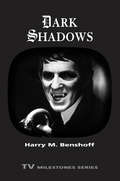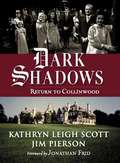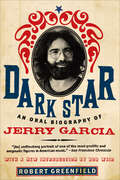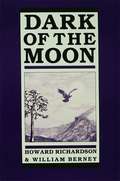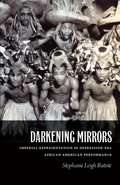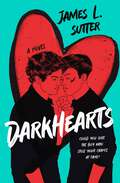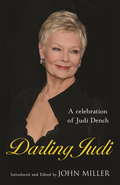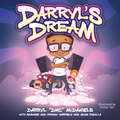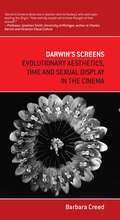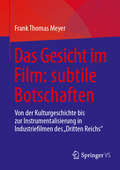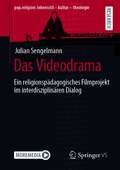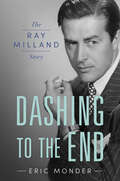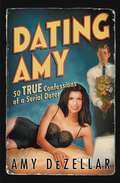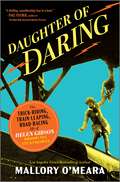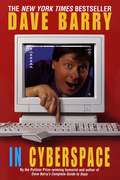- Table View
- List View
Dark Shadows: Dark Shadows (Tv Milestones Ser.)
by Harry M. BenshoffExplores the cultural, industrial, formal, and generic contexts of the television soap opera Dark Shadows as a precursor to today's popular gothic media franchises.
Dark Shadows: Return to Collinwood
by Kathryn Leigh Scott Jim Pierson Jonathan FridDark Shadows: Return to Collinwood presents a look back at four decadesof the successful spooky soap opera that made sympathetic vampire Barnabas Collins a pop culture phenomenon and prompted the big-budget, big-screen Warner Bros. revival starring longtime fan Johnny Depp, directed by Tim Burton, that premieres May 11, 2012. The large format book includes color photographs and behind-the-scenes anecdotes from Kathryn Leigh Scott and three other original cast members who filmed cameo roles with Johnny Depp, Helene Bonham-Carter and Michelle Pfeiffer in the new Gothic epic. With the ongoing fascination for all things vampiric, this book about the making of the new film and the history of the original series will be an enticing volume for new and old fans alike.This book also features hundreds of exclusive photographs of Dark Shadows then and now, along with behind-the-scenes information, production materials and unique archival elements that provide context for the Depp/Burton Warner Bros. film.The suspenseful Gothic tales of Dark Shadows center on the wealthy but tormented inhabitants of the mysterious Collinwood estate in the small fishing village of Collinsport, Maine, where the powerful Collins family has been haunted for generations by vengeful curses and other supernatural secrets that span the centuries.
Dark Star: An Oral Biography of Jerry Garcia
by Robert GreenfieldFor more than thirty years, Jerry Garcia was the musical and spiritual center of the Grateful Dead, one of the most popular rock bands of all time. In Dark Star, the first biography of Garcia published after his death, Garcia is remembered by those who knew him best. Together the voices in this oral biography explore his remarkable life: his childhood in San Francisco; the formation of his musical identity; the Dead's road to rock stardom; and his final, crushing addiction to heroin. Interviews with Jerry's former wives, lovers, family members, close friends, musical partners, and cultural cohorts create a behind-the-scenes look at the making of a rock-and-roll icon—and at the price of fame.
Dark Victory: The Life of Bette Davis
by Ed SikovThe legendary Hollywood star blazes a fiery trail in this enthralling portrait of a brilliant actress and the movies her talent elevated to greatnessShe was magnificent and exasperating in equal measure. Jack Warner called her "an explosive little broad with a sharp left." Humphrey Bogart once remarked, "Unless you're very big she can knock you down." Bette Davis was a force of nature—an idiosyncratic talent who nevertheless defined the words "movie star" for more than half a century and who created an extraordinary body of work filled with unforgettable performances. In Dark Victory, the noted film critic and biographer Ed Sikov paints the most detailed picture ever delivered of this intelligent, opinionated, and unusual woman who was—in the words of a close friend—"one of the major events of the twentieth century." Drawing on new interviews with friends, directors, and admirers, as well as archival research and a fresh look at the films, this stylish, intimate biography reveals Davis's personal as well as professional life in a way that is both revealing and sympathetic. With his wise and well-informed take on the production and accomplishments of such movie milestones as Jezebel, All About Eve, and Now, Voyager, as well as the turbulent life and complicated personality of the actress who made them, Sikov's Dark Victory brings to life the two-time Academy Award–winning actress's unmistakable screen style, and shows the reader how Davis's art was her own dark victory.
Dark of the Moon
by Howard Richardson William BerneyAs the tale unfolds, a witch boy tarries in a mountain community in love with a beautiful girl named Barbara Allen. The superstitious townspeople resent their happiness and their subsequent meddling ends in violence and tragedy. This play was proclaimed a Broadway hit.
Darkbeast
by Morgan KeyesA girl's love for her raven may put her life in jeopardy in this gripping tale.In Keara's world, every child has a darkbeast--a creature that takes dark emotions like anger, pride, and rebellion. Keara's darkbeast is Caw, a raven, and Keara can be free of her worst feelings by transferring them to Caw. He is her constant companion, and they are magically bound to each other until Keara's twelfth birthday. For on that day Keara must kill her darkbeast--that is the law. Refusing to kill a darkbeast is an offense to the gods, and such heresy is harshly punished by the feared Inquisitors. But Keara cannot imagine life without Caw. And she finds herself drawn to the Travelers, actors who tour the country performing revels. Keara is fascinated by their hints of a grand life beyond her tiny village. As her birthday approaches, Keara readies herself to leave childhood--and Caw--behind forever. But when the time comes for the sacrifice, will she be able to kill the creature that is so close to her? And if she cannot, where will she turn, and how can she escape the Inquisitors?
Darkbeast Rebellion
by Morgan KeyesBetrayal threatens everything Keara dreams of in this fast-paced, exciting sequel to Darkbeast. Keara, her friend Goran, and the wily old actor, Taggart, are fleeing for their lives. They have all spared their darkbeasts, the creatures that take on their darker deeds and emotions and lift their spirits. But their actions defy the law, which dictates that all citizens must kill their darkbeasts on their twelfth birthdays. There are rumors of safe havens, groups of people called Darkers who spared their darkbeasts and live outside the law. To find the Darkers, the trio must embark on a dangerous journey—and evade the Inquisitors who are searching for them everywhere. In the middle of winter, freezing and exhausted, Keara and her companions are taken to an underground encampment that seems the answer to all their hopes. But are these Darkers really what they appear to be?
Darkening Mirrors: Imperial Representation in Depression-Era African American Performance
by Stephanie Leigh BatisteIn Darkening Mirrors, Stephanie Leigh Batiste examines how African Americans participated in U.S. cultural imperialism in Depression-era stage and screen performances. A population treated as second-class citizens at home imagined themselves as empowered, modern U.S. citizens and transnational actors in plays, operas, ballets, and films. Many of these productions, such as the 1938 hits Haiti and The "Swing" Mikado recruited large casts of unknown performers, involving the black community not only as spectators but also as participants. Performances of exoticism, orientalism, and primitivism are inevitably linked to issues of embodiment, including how bodies signify blackness as a cultural, racial, and global category. Whether enacting U.S. imperialism in westerns, dramas, dances, songs, jokes, or comedy sketches, African Americans maintained a national identity that registered a diasporic empowerment and resistance on the global stage. Boldly addressing the contradictions in these performances, Batiste challenges the simplistic notion that the oppressed cannot identify with oppressive modes of power and enact themselves as empowered subjects. Darkening Mirrors adds nuance and depth to the history of African American subject formation and stage and screen performance.
Darkhearts: A Novel
by James L. SutterPerfect for fans of Alice Oseman and Red, White, & Royal Blue, Darkhearts is a hilarious, heartfelt, enemies-to-lovers romance about love, celebrity, and what happens when the two collide.When David quit his band, he missed his shot at fame, trapped in an ordinary high school life while his ex–best friend, Chance, became the hottest teen pop star in America.Then tragedy throws David and Chance back into contact. As old wounds break open, the boys find themselves trading frenemy status for a confusing, secret romance—one that could be David’s ticket back into the band and the spotlight.As the mixture of business and pleasure becomes a powder keg, David will have to choose: Is this his second chance at glory? Or his second chance at Chance?
Darkness Calls: A Critical Investigation of Neo-Noir
by Sue ShortThis book examines the contrasting forms neo-noir has taken on screen, asking what prompts our continued interest in tales of criminality and moral uncertainty. Neo-noir plots are both familiar and diverse, found in a host of media formats today, and now span the globe. Yet despite its apparent prevalence—and increased academic attention—many core questions remain unanswered. What has propelled noir’s appeal, half a century on after its supposed decline? What has led film-makers and series-creators to rework given tropes? What debates continue to divide critics? And why are we, as viewers, so drawn to stories that often show us at our worst? Referencing a range of films and series, citing critical work in the field—while also challenging many of the assumptions made—this book sets out to advance our understanding of a subject that has fascinated audiences and academics alike. Theories relating to gender identity and neo-noir’s tricky generic status are discussed, together with an evaluation of differing comic inflections and socio-political concerns, concluding that, although neo-noir is capable of being both progressive and reactionary, it also mobilises potentially radical questions about who we are and what we might be capable of.
Darling Judi: A Celebration of Judi Dench
by VariousA celebration of Britain's favourite actress, Judi DenchThe very name Judi Dench encourages a warm and admiring response from the public and fellow actors alike. Her wide-ranging career includes numerous Shakespearean performances (most recently in ALL'S WELL THAT ENDS WELL at the RSC) and contemporary theatre (in plays by, among others, David Hare and Hugh Whitemore); on television (in the series A FINE ROMANCE and AS TIME GOES BY) and in the cinema (MRS BROWN, her Oscar-winning performance in SHAKESPEARE IN LOVE, THE SHIPPING NEWS, IRIS, and in four James Bond films as 'M').Judi Dench is as popular as she is talented - when she and Maggie Smith appeared together in a David Hare play last year all seats were sold for the entire run within 24 hours.John Miller, her biographer, invited fellow actors, writers, and people of the theatre, film and television, to illustrate her genius and her character from their own experience and perspective. With contributors ranging from Billy Connolly to Hugh Whitemore, Bob Larbey to Tim Pigott-Smith, this is a unique portrait of the legend that is Dame Judi Dench.
Darling Judi: A Celebration of Judi Dench
by VariousA celebration of Britain's favourite actress, Judi DenchThe very name Judi Dench encourages a warm and admiring response from the public and fellow actors alike. Her wide-ranging career includes numerous Shakespearean performances (most recently in ALL'S WELL THAT ENDS WELL at the RSC) and contemporary theatre (in plays by, among others, David Hare and Hugh Whitemore); on television (in the series A FINE ROMANCE and AS TIME GOES BY) and in the cinema (MRS BROWN, her Oscar-winning performance in SHAKESPEARE IN LOVE, THE SHIPPING NEWS, IRIS, and in four James Bond films as 'M').Judi Dench is as popular as she is talented - when she and Maggie Smith appeared together in a David Hare play last year all seats were sold for the entire run within 24 hours.John Miller, her biographer, invited fellow actors, writers, and people of the theatre, film and television, to illustrate her genius and her character from their own experience and perspective. With contributors ranging from Billy Connolly to Hugh Whitemore, Bob Larbey to Tim Pigott-Smith, this is a unique portrait of the legend that is Dame Judi Dench.
Darryl's Dream
by Darryl "DMC" McDaniels Shawnee Warfield Johnny Warfield Adam PadillaFrom hip-hop pioneer Darryl &“DMC&” McDaniels comes Darryl&’s Dream, a new picture book about creativity, confidence, and finding your voice.Meet Darryl, a quiet third grader with big hopes and dreams. He loves writing and wants to share his talents, but he&’s shy—and the kids who make fun of his glasses only make things worse. Will the school talent show be his chance to shine? Darryl&’s Dream, by iconic performer Darryl "DMC" McDaniels, is a story about finding confidence, facing bullies, and celebrating yourself. This full-color picture book is certain to entertain children and parents with its charming art and important message.
Darwin's Screens: Evolutionary Aesthetics, Time and Sexual Display in the Cinema
by Barbara CreedDarwin's Screens addresses a major gap in film scholarship—the key influence of Charles Darwin's theories on the history of the cinema. Much has been written on the effect of other great thinkers such as Freud and Marx but very little on the important role played by Darwinian ideas on the evolution of the newest art form of the twentieth century. Creed argues that Darwinian ideas influenced the evolution of early film genres such as horror, the detective film, science fiction, film noir and the musical. Her study draws on Darwin's theories of sexual selection, deep time and transformation, and on emotions, death, and the meaning of human and animal in order to rethink some of the canonical arguments of film and cinema studies.
Das Gesicht im Film: Von der Kulturgeschichte bis zur Instrumentalisierung in Industriefilmen des "Dritten Reichs"
by Frank Thomas MeyerDas menschliche Gesicht gilt einerseits als subtiler, „schwacher Code“, das sich im Alltag den Deutungen der menschlichen Wahrnehmung immer wieder zu entziehen scheint. Andererseits wird gerade in Medien wie dem Film das Gesicht strategische eingesetzt, um unterschwellig Botschaften zu vermitteln. Die Bild-Werdung des Menschen hat, wie diese Arbeit zeigt, nicht erst mit dem Aufkommen von Diktaturen seine „Unschuld“ verloren. Aber erst im Modus seiner Lesbarmachung, als still gestelltes Bild wie es in Form der Großaufnahme im Film zur Geltung kommt, kann es als scheinbare Evidenz seine manipulierende Funktion einnehmen.Ob in Deutschland, Italien oder Russland – alle diese Diktaturen wollen sich zu Beginn des 20. Jahrhunderts der Arbeiterschaft versichern, um ihre ideologischen Ziele zu verwirklichen. Das kulturell und symbolisch vorgeprägte Gesicht, muss daher für die Propaganda umcodiert werden. Dem immer noch weit verbreiteten Verdikt der „Gleichschaltung“ wird jedoch in diesem Buch differenziert gegenübergetreten: Die Möglichkeiten des Gesichts, es für unterschiedlichen historischen Konstellationen und Herausforderungen anzupassen und zu instrumentalisieren, machen es zu einem facettenreichen Medium für rhetorische Strategien.
Das Theater der Elektrizität: Technologie und Spektakel im ausgehenden 19. Jahrhundert (Szene & Horizont. Theaterwissenschaftliche Studien #6)
by Ulf OttoDas Theater der Moderne gründet sich auf ästhetische Energien. Seit den 1880er Jahren aber sind es elektrische Energien, aus fossilen Brennstoffen in Kraftwerken erzeugt, die im Theater zu zirkulieren beginnen. Installiert wird eine mysteriöse Entität, die noch als Lebenskraft gehandelt wird und schon für Fortschritt durch Technik steht. Mit der Elektrifizierung des Theaters wird Elektroindustrie respektabel und Bühnenkunst modernistisch. Entsorgt werden die Kulissen, die im Scheinwerferlicht nur noch verstaubt erscheinen, und aus der Bildermaschine wird Raumkunst. Doch wichtiger sind die institutionellen Transformationen, die sich in bislang unbeachteten Koalitionen, Kontinuitäten und Konkurrenzen von technischen und ästhetischen Dingen abspielen. Ingenieurswissen, Kontrolltechniken und Versorgungssysteme ändern, wie Theater und Gesellschaft verschaltet sind. Der Interaktionsraum (zwischen-)menschlicher Leiblichkeit des 20. Jahrhunderts entpuppt sich als eine technische Konstellation.
Das Videodrama: Ein religionspädagogisches Filmprojekt im interdisziplinären Dialog (pop.religion: lebensstil – kultur – theologie)
by Julian SengelmannDas religionspädagogische und praktisch-theologische Projekt VIDEODRAMA ist ein hybrider, interdisziplinärer Ansatz, bei dem mit einer Gruppe in einem kreativen Prozess ein Film produziert wird, der im „Raum eines biblischen Textes“ entsteht. Die Teilnehmenden entwickeln diese Filmerzählung in allen Facetten einer klassischen Filmproduktion bis hin zur Premiere in einem Kino. Das VIDEODRAMA ist ein interdisziplinäres Projekt, das sich dezidiert von wissenschaftlichen Konkurrenzen und Konzeptionen loslöst. Dieses Buch begleitet exemplarisch einen solchen Prozess, entwickelt eine Theorie des VIDEODRAMAS und bringt diese mit ausgewählten aktuellen religionspädagogischen Diskussionen ins Gespräch.
Dashing to the End: The Ray Milland Story (Hollywood Legends Series)
by Eric MonderBorn Alfred Reginald John Truscott-Jones, Welsh American actor Ray Milland (1907–1986) appeared in more than 135 theatrical releases between 1929 and 1985 and on radio, television, and the stage, while also becoming a film director; Milland’s extensive canon across such a period is remarkable, especially considering his lack of formal training, his belated start in show business in his late twenties, and the fact he only lived to age seventy-nine. Perhaps best remembered for his Oscar-winning performance as the tortured alcoholic in Billy Wilder’s The Lost Weekend (1945) or his outstanding collaboration with Alfred Hitchcock in Dial M for Murder (1954), there is much more to Milland’s life and career than the few films that elevated him from star to icon. Despite his prolific and successful career, Dashing to the End: The Ray Milland Story is the first comprehensive biography of the star. Milland’s personal and professional trajectory epitomize quintessential Hollywood lore: the British army soldier-turned-actor who went from unknown, struggling bit player to Oscar-winning star to aging, scandal-haunted “has-been” to comeback character actor to present-day cult figure. Using interviews with Milland’s costars and colleagues, as well as research from several major archives, author Eric Monder brings into sharp relief both the positive and negative aspects of the Hollywood film and television industries and paints a well-rounded portrait of this complex man and artist.
Date Night Ideas for Couples: Fun Ways to Connect with Your Partner for an Entertaining Night
by Angela Nicole HoltonMake date night more fun!Date nights can become a "been there, done that" ritual—but with new ways to spend time together, your dates can be full of fun and unique experiences to share with your partner. In this playful relationship book for couples, you'll find more than 80 original ideas for leveling up date night—whether you're 25 or 85.Pick an idea, make a plan—Spend your time having fun, instead of brainstorming ideas, with brief date descriptions, planning tips, and suggested conversation starters.Shake up your dates—Grow closer as a couple with alternatives to your average date nights, including going on a lover's hike, taking a virtual cooking class, and writing a bedtime story together.Designed for any budget—Many of these dates only require your time, energy, and imagination in order to enjoy more quality time together.Keep your relationship fresh with this delightful book of date night ideas.
Dating Amy: 50 True Confessions of a Serial Dater
by Amy DezellarDating today can seem like Alices tumble down the rabbit hole into Wonderland. Whether starting out or starting again, women face the difficult task of sorting through the good (guy), the bad (boy), and the ugly (morning after) in their search for Mr. Right. Here to give hope to smart single women everywhere is Amy DeZellar, who bravely dedicated two years of her life to debunking common dating myths and documenting 50 of her dates. Shes gone wine-tasting with Indentured Cats, on a blind date who also happens to be blind, and found her artistic sentiments at odds with her desire for financial security when she simultaneously got involved with a painter named Harry Potter and a NASA super-computer designer named Teflon, all in her quest to find true love. Each of the 50 chapters in this book is dedicated to a different date, and includes the kinds of tips and sharp observations that only someone on the front lines can offer. Get ready to laugh, cry, and commiserate with Amyand learn, as she did, a few things about finding the perfect man.
Daughter of Daring: The Trick-Riding, Train-Leaping, Road-Racing Life of Helen Gibson, Hollywood’s First Stuntwoman
by Mallory O'MearaFrom Los Angeles Times bestselling author Mallory O'Meara, the exhilarating story of America's first professional stuntwoman, Helen Gibson, who worked during a time when women ruled Hollywood Helen Gibson was willing to do anything to give audiences a thrill. Advertised as &“The Most Daring Actress in Pictures,&” Helen emerged in the early days of the twentieth-century silent film scene as a rodeo rider, producer, performer and stunt double for iconic stars of the era. Her exploits were as dangerous as they were glamorous, featured in hundreds of films and serials—yet her legacy was quickly overshadowed by the increasingly hypermasculine and male-dominated evolution of action films in the decades that would follow her. In this fast-paced and feminist biography, award-winning author Mallory O'Meara presents Helen&’s life and career in exhilarating detail, including:• Helen&’s rise to fame in The Hazards of Helen, the longest-running serial in history • How Helen became the first-ever stuntwoman in American film • The pivotal and overlooked role of Helen&’s contemporaries—including female directors, stars and stuntwomen who shaped the making of narrative film. Through the page-turning story of Helen&’s pioneering legacy, Mallory O'Meara gives readers a glimpse of the Golden Age of Hollywood that could have been: an industry where women call the shots.
Daughter of the Dragon: Anna May Wong's Rendezvous with American History
by Yunte HuangOne of the Atlantic's "Books to Get Lost in This Summer" Best Books of August 2023: New York Times Book Review, Christian Science Monitor, InsideHook, BookRiot, WNET AllArts, Arlington Magazine A trenchant reclamation of the Chinese American movie star, whose battles against cinematic exploitation and endemic racism are set against the currents of twentieth-century history. Born into the steam and starch of a Chinese laundry, Anna May Wong (1905–1961) emerged from turn-of-the-century Los Angeles to become Old Hollywood’s most famous Chinese American actress, a screen siren who captivated global audiences and signed her publicity photos—with a touch of defiance—“Orientally yours.” Now, more than a century after her birth, Yunte Huang narrates Wong’s tragic life story, retracing her journey from Chinatown to silent-era Hollywood, and from Weimar Berlin to decadent, prewar Shanghai, and capturing American television in its infancy. As Huang shows, Wong’s rendezvous with history features a remarkable parade of characters, including a smitten Walter Benjamin and (an equally smitten) Marlene Dietrich. Challenging the parodically racist perceptions of Wong as a “Dragon Lady,” “Madame Butterfly,” or “China Doll,” Huang’s biography becomes a truly resonant work of history that reflects the raging anti-Chinese xenophobia, unabashed sexism, and ageism toward women that defined both Hollywood and America in Wong’s all-too-brief fifty-six years on earth.
Dave Barry in Cyberspace
by Dave Barry"RELENTLESSLY FUNNY . . . BARRY SHINES." --People. A self-professed computer geek who actually does Windows 95, bestselling humorist Dave Barry takes us on a hilarious hard drive via the information superhighway--and into the very heart of cyberspace, asking the provocative question: If God had wanted us to be concise, why give us so many fonts? Inside you'll find juicy bytes on How to Buy and Set Up a Computer; Step One: Get Valium Nerdstock in the Desert; Or: Bill Gates Is Elvis Software: Making Your Computer Come Alive So It Can Attack You Word Processing: How to Press an Enormous Number of Keys Without Ever Actually Writing Anything Selected Web Sites, including Cursing in Swedish, Deformed Frog Pictures, and The Toilets of Melbourne, Australia And much, much more! "VERY FUNNY ... After a day spent staring at a computer monitor, think of the book as a kind of screen saver for your brain." --New York Times Book Review
Dave Barry's Bad Habits: A 100% Fact-free Book
by Dave BarryIf you're not already acquainted--nay, infatuated--with the works of the man who the New York Times calls "the funniest man in America," you can get cracking right now with this all-time favorite collection of Dave Barry's humor columns. Dave Barry's Bad Habits won't rot your teeth, cause your insurance premiums to go up, or make your kids go cross-eyed if they sit too close to it. It will, however, make you laugh so hard your middle actually moves (the best exercise, and possibly the only kind you'll be interested in after forty). Here, preserved for all time, are Barry's profoundest musings on such topics as how to get kids to stop smoking (eliminate tenth grade), what to do if your car is making loud noises (turn up the radio), and a solution to the battle of the sexes (let the men do housework, say, for the next six thousand years to even things up). Together they serve to expose the little insanities of everyday life and assure us that we're not completely alone in a world gone mad.
Dave Barry's Book of Bad Songs
by Dave BarryBased on the results from Dave Barry's monumental survey, Dave Barry's Book of Bad Songs is a compilation of some of the worst songs ever written, including such special categories as Teen Death Songs, Songs That People Always Get Wrong.
